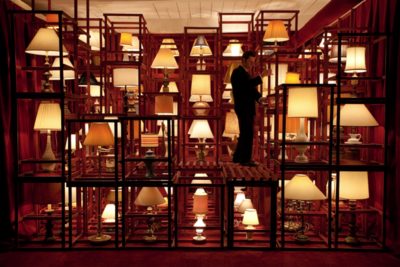Exploring a Labyrinth: Fertile Solitude at the Mills Gallery

Megan and Murray McMillan, While She Waits for the Light, 2009. All photos courtesy Boston Center for the Arts.
By Olivia J. Kiers
Fertile Solitude at the Boston Center for the Arts’ Mills Gallery has as much to do with searching as it does with solitude. The show’s enchanting, chaotic organization (referred to as a “maze” in the exhibition literature) encourages the visitor to explore rather than simply view the art. “It forces a one-on-one experience with the art, but also offers a variety of paths. It’s a balance of parameters and freedom,” says curator Elizabeth Devlin. A refreshing rejection of the white gallery cube in favor of faux hedges, acute angles and enticing soundscapes, Fertile Solitude is also interactive, irreverent and full of introspective potential.
Physicality is one key to Fertile Solitude’s emotive success. There is a tactile quality to much of the art, from Sarah Wentworth’s nook cluttered with rubbings of hotel room numbers on paper, to Caleb Cole’s installation His Room, in which viewers are invited to “gently examine” vintage objects within a recreation of an adolescent boy’s bedroom from the mid-20th century. (Both of these works also convey a palpable suggestion of intrusion, an interesting counterpoint to the show’s invitation to introspection.) Other works capitalize on light’s evocative power. The glare of disembodied auto headlights in Hao Ni’s Night Sculptures creates a tone of anxiety. Equally unusual yet perhaps more comforting, Megan and Murray McMillan’s While She Waits for the Light bathes the viewer in incandescent light that glows from a wall of stacked table lamps. While the stars of the show are these installation-style works, the accompanying paintings and photographs hold their own. Emily Evelth’s Colloquy, an oil painting that allows its mylar support to un-scroll itself all the way to the gallery floor in a unique activation of negative space, is a prime example of Fertile Solitude’s confident quirkiness.

Emily Eveleth, Colloquy (detail), 2014, oil on mylar.
At its core, the show is “an escape from the everyday hustle and bustle” as Devlin says, yet this is also a show that has chosen “ordinary” life as a muse for extraordinary art—the second key to its success. Accessibility is important. “It’s a unique beast, a group show that you can approach no matter your background… There’s some positive takeaway for everyone, whether it’s the narrative that resonates, or the use of space.” For example, it’s a rare person indeed who hasn’t experienced cravings for unhealthy food, or noticed the bad-boy appeal of smoking a cigarette in bed, both portrayed in Annette Lemieux’s darkly humorous Bad Habits.
Fertile Solitude is the kind of exhibition one can discuss for days after experiencing it. It offers visual appeal while resisting the shallow glitz of the Instagram-ready moment. It is a curated game one can play without feeling patronized. There are questions without straightforward responses, and statements that leave one wondering. Ultimately the show’s success lies in the fact that it is, indeed, a place for fertile solitude.
Fertile Solitude is on view through December 18.
